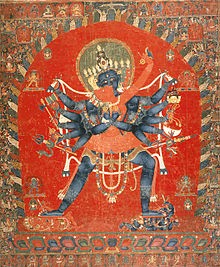Chakrasamvara
Chakrasamvara (from Sanskrit : Chakra - Samvara ; Tibetan : Korlo Demchok , wylie .: 'Khor lo bde mchog ; English: the binding of the wheels "the wheel of supreme bliss") is a wrathful yidam of Tibetan Buddhism surrounded by a wreath of flames . He is usually represented with a blue body color, four heads of different colors and twelve arms in sexual union ( Yab-Yum ) with his companion Vajravarahi . The Chakrasamvara Tantra is of great importance in the schools of the New Translation Tradition of Tibetan Buddhism.
The deity practice on Chakrasamvara belongs to the anuttarayoga tantra (unsurpassable yoga tantra ), specifically to the so-called mother tantras , in which attachment is seen as the main feeling of disturbance, in contrast to the father tantras , in which it is anger and the non-dual tantras , in which it's confusion. This tantra class corresponds to the Mahayoga level of the ancient translation tradition of Tibet .
origin
According to tradition, the Chakrasamvara Tantra, also known as Śriheruka-abhidhāna or Laghusamvara (which means something like bliss-light due to the brevity of the text ), was first introduced in the middle to the end of the 8th century AD through the Sambhogakaya - Dakini Vajravarahi conferred to human adepts in India . It is a relatively short text of about seven hundred stanzas in Sanskrit , mainly describing mantras and rituals. Judging by its historical origin, the Chakrasamvara Tantra is closely connected with the divine world of Shivaism . According to the myth, Vajradhara in the form of Chakrasamvara is said to have broken the power of the world-ruling Hindu god Ïoevara (an emanation of Ishvara ) out of compassion for those striving for liberation from samsara .
Chakrasamvara is one of the so-called eight great Heruka deities (blood drinkers), alongside Hayagriva , Guhyasamaja , Hevajra , Vajrakilaya , Yamantaka , Amrita and Mamo . The root tantras of these deities are among the most important texts of tantric Buddhism in India and Tibet .
literature
- Kazi Dawa-Samdup: Shrîchakrasambhâra Tantra. A Buddhist Tantra . Aditya Prakashan, New Delhi 1987, ISBN 0-88181-000-2
- Geshe Kelsang Gyatso , Essence of Vajrayana. The Highest Yoga Tantra practice of Heruka body mandala . Tharpa Publications, Glen Spey, New York 2003, ISBN 0-948006-48-X
Web links
- Literature by and about Chakrasamvara in the catalog of the German National Library
- Encyclopedia of Religion on Chakrasamvara (English)
- Book review The Circle of Bliss - Buddhist Meditational Art
- emmet.de about the Kailash and Chakrasamvara
- tibet.de about the Kailash and Chakrasamvara
- thangka.de Ten Chakrasamvara scrolls
